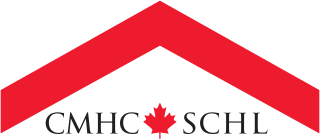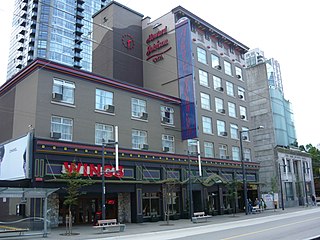Stress management consists of a wide spectrum of techniques and psychotherapies aimed at controlling a person's level of stress, especially chronic stress, usually for the purpose of improving everyday functioning. Stress produces numerous physical and mental symptoms which vary according to each individual's situational factors. These can include a decline in physical health, such as headaches, chest pain, fatigue, and sleep problems, as well as depression. The process of stress management is named as one of the keys to a happy and successful life in modern society. Life often delivers numerous demands that can be difficult to handle, but stress management provides a number of ways to manage anxiety and maintain overall well-being.

Canada Mortgage and Housing Corporation is Canada's federal crown corporation responsible for administering the National Housing Act, with the mandate to improve housing by living conditions in the country.

Safety culture is the collection of the beliefs, perceptions and values that employees share in relation to risks within an organization, such as a workplace or community. Safety culture is a part of organizational culture, and has been described in a variety of ways, notably the National Academies of Science and the Association of Land Grant and Public Universities have published summaries on this topic in 2014 and 2016.

Workplace violence, violence in the workplace, or occupational violence refers to violence, usually in the form of physical abuse or threat, that creates a risk to the health and safety of an employee or multiple employees. The National Institute for Occupational Safety and Health defines worker on worker, personal relationship, customer/client, and criminal intent all as categories of violence in the workplace. These four categories are further broken down into three levels: Level one displays early warning signs of violence, Level two is slightly more violent, and level three is significantly violent. Many workplaces have initiated programs and protocols to protect their workers as the Occupational Health Act of 1970 states that employers must provide an environment in which employees are free of harm or harmful conditions.
Workplace wellness, also known as corporate wellbeing outside the United States, is a broad term used to describe activities, programs, and/or organizational policies designed to support healthy behavior in the workplace. This often involves health education, medical screenings, weight management programs, and onsite fitness programs or facilities. It can also include flex-time for exercise, providing onsite kitchen and eating areas, offering healthy food options in vending machines, holding "walk and talk" meetings, and offering financial and other incentives for participation.
A virtual workplace is a work environment where employees can perform their duties remotely, using technology such as laptops, smartphones, and video conferencing tools. A virtual workplace is not located in any one physical space. It is usually a network of several workplaces technologically connected without regard to geographic boundaries. Employees are thus able to interact in a collaborative working environment regardless of where they are located. A virtual workplace integrates hardware, people, and online processes.

A mortgage loan or simply mortgage, in civil law jurisdictions known also as a hypothec loan, is a loan used either by purchasers of real property to raise funds to buy real estate, or by existing property owners to raise funds for any purpose while putting a lien on the property being mortgaged. The loan is "secured" on the borrower's property through a process known as mortgage origination. This means that a legal mechanism is put into place which allows the lender to take possession and sell the secured property to pay off the loan in the event the borrower defaults on the loan or otherwise fails to abide by its terms. The word mortgage is derived from a Law French term used in Britain in the Middle Ages meaning "death pledge" and refers to the pledge ending (dying) when either the obligation is fulfilled or the property is taken through foreclosure. A mortgage can also be described as "a borrower giving consideration in the form of a collateral for a benefit (loan)".
Occupational rehabilitation is the science and practices of returning injured workers to a level of daily work activities that is appropriate to their functional and cognitive capacity related to their position of which may be influenced by the severity of a worker's injuries.
Occupational health psychology (OHP) is an interdisciplinary area of psychology that is concerned with the health and safety of workers. OHP addresses a number of major topic areas including the impact of occupational stressors on physical and mental health, the impact of involuntary unemployment on physical and mental health, work-family balance, workplace violence and other forms of mistreatment, psychosocial workplace factors that affect accident risk and safety, and interventions designed to improve and/or protect worker health. Although OHP emerged from two distinct disciplines within applied psychology, namely, health psychology and industrial and organizational psychology, for a long time the psychology establishment, including leaders of industrial/organizational psychology, rarely dealt with occupational stress and employee health, creating a need for the emergence of OHP. OHP has also been informed by other disciplines, including occupational medicine, sociology, industrial engineering, and economics, as well as preventive medicine and public health. OHP is thus concerned with the relationship of psychosocial workplace factors to the development, maintenance, and promotion of workers' health and that of their families. The World Health Organization and the International Labour Organization estimate that exposure to long working hours causes an estimated 745,000 workers to die from ischemic heart disease and stroke in 2016, mediated by occupational stress.
Public housing policies in Canada includes rent controls, as well as subsidized interest rates and grants. Early public housing policy in Canada consisted of public-private lending schemes which focused on expanding home ownership among the middle class. The first major housing initiative in Canada was the Dominion Housing Act of 1935, which increased the amount of credit available for mortgage loans.

Occupational stress is psychological stress related to one's job. Occupational stress refers to a chronic condition. Occupational stress can be managed by understanding what the stressful conditions at work are and taking steps to remediate those conditions. Occupational stress can occur when workers do not feel supported by supervisors or coworkers, feel as if they have little control over the work they perform, or find that their efforts on the job are incommensurate with the job's rewards. Occupational stress is a concern for both employees and employers because stressful job conditions are related to employees' emotional well-being, physical health, and job performance. The World Health Organization and the International Labour Organization conducted a study. The results showed that exposure to long working hours, operates through increased psycho-social occupational stress. It is the occupational risk factor with the largest attributable burden of disease, according to these official estimates causing an estimated 745,000 workers to die from ischemic heart disease and stroke events in 2016.
A “toxic workplace” is a colloquial metaphor used to describe a place of work, usually an office environment, that is marked by significant personal conflicts between those who work there. A toxic work environment has a negative impact on an organization's productivity and viability. This type of environment can be detrimental to both the effectiveness of the workplace and the well-being of its employees.

Affordable housing in Canada is living spaces that are deemed financially accessible to those with a median household income in Canada. The property ladder continuum of affordable housing in Canada includes market, non-market, and government-subsidized housing.
Workplace health promotion is the combined efforts of employers, employees, and society to improve the mental and physical health and well-being of people at work. The term workplace health promotion denotes a comprehensive analysis and design of human and organizational work levels with the strategic aim of developing and improving health resources in an enterprise. The World Health Organization has prioritized the workplace as a setting for health promotion because of the large potential audience and influence on all spheres of a person's life. The Luxembourg Declaration provides that health and well-being of employees at work can be achieved through a combination of:
A psychosocial hazard or work stressor is any occupational hazard related to the way work is designed, organized and managed, as well as the economic and social contexts of work. Unlike the other three categories of occupational hazard, they do not arise from a physical substance, object, or hazardous energy.
First National Financial Corporation is the parent company of First National Financial LP, a Canadian private lending institution based in Toronto, Ontario. First National is among the top three in market share in the mortgage broker distribution channel.
Occupational cardiovascular diseases (CVD) are diseases of the heart or blood vessels caused by working conditions, making them a form of occupational illness. These diseases include coronary heart disease, stroke, cardiomyopathy, arrythmia, and heart valve or heart chamber problems. Cardiovascular disease is the leading cause of death in the United States and worldwide. In the United States, cardiovascular diseases account for one out of four deaths. The 6th International Conference on Work Environment and Cardiovascular Diseases found that within the working age population about 10-20% of cardiovascular disease deaths can be attributed to work. Ten workplace stressors and risk factors were estimated to be associated with 120,000 U.S. deaths each year and account for 5-8% of health care costs.

Sleep is a naturally recurring state of mind and body, characterized by altered consciousness, relatively inhibited sensory activity, reduced muscle activity, and inhibition of nearly all voluntary muscles during rapid eye movement (REM) sleep, and reduced interactions with surroundings. An essential aspect of sleep is that it provides the human body with a period of reduced functioning that allows for the systems throughout the body to be repaired. This time allows for the body to recharge and return to a phase of optimal functioning. It is recommended that adults get 7 to 9 hours of sleep each night. Sleep is regulated by an internal process known as the circadian rhythm. This 24-hour cycle regulates periods of alertness and tiredness that an individual experiences. The correlation between psychological stress and sleep is complex and not fully understood. In fact, many studies have found a bidirectional relationship between stress and sleep. This means that sleep quality can affect stress levels, and stress levels can affect sleep quality. Sleep change depends on the type of stressor, sleep perception, related psychiatric conditions, environmental factors, and physiological limits.
Phyllis Moen is an American sociologist. She is the McKnight Presidential Chair in Sociology at the University of Minnesota, and was previously the Ferris Family Professor of Life Course Studies at Cornell University. While at Cornell she founded the Bronfenbrenner Life Course Center, as well as the Cornell Careers Institute, an Alfred P. Sloan Working Families Center.
Anne-Marie Chang is a researcher in the fields of sleep and circadian rhythms and is currently an Assistant Professor of Bio-behavioral Health at Pennsylvania State University. She earned her Ph.D. in neuroscience from Northwestern University in 2003.






